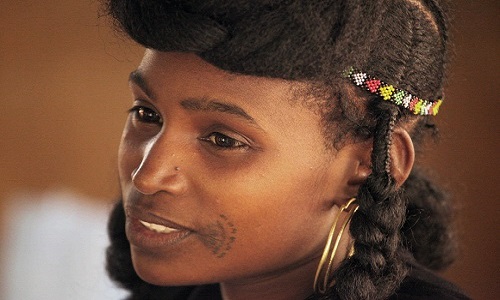13,469 total views, 2 views today
Nigerian women are known to be lovers of fashion from time immemorial. They wear certain clothes, jewelries and make their hair so as to beautify themselves and make them have the woman look. Tattoos, use of cowries shell and beads as jewelries are common among the women in the olden days. There are different ways women express their fashion taste in the olden days. Most of these practices are still in vogue today. This signifies that women’ fashion is rooted in the culture and not a new thing.
- Clothing
Clothes are one of the ways Nigerian women adore themselves and cover their nakedness. They mostly wear them as Iro and Buba with different styles. Some prefer the short Iro and buba known as Oleku while some culture adorene themselves with wrappers with blouses. The common fabrics are tie and dye products, aso oke, aran. Weaving and the production of “ofi” were in vogue in those days. Embroided cloth was common among the Hausa people. Head gears are also used to complement the clothes.
- Hair-Making
The hair is seen as the glory of a woman and is expected to be given great attention. Women with long hair are given more respect while those with no or short hair are looked down upon by people. Women plait or weave their hairs in crows or different styles. Women only shave their hair on the loss of their husbands. They plait their hairs firmly from the roots of the scalp with rubber, wool or threads. Common hair braiding/plaiting/threading styles include koroba, ipako elede, kolese, kojusoko, suku among others.
Women wear different hairstyles on different occasions. Hairstyles also varies as they grow, reach maturity and as they reach different stages of womanhood. The hairstyle worn by a maiden will be different from the one on a married woman, which will also be different from the hairstyle on an expecting mother.
In some culture (Yoruba and Igbo), a girl wear a hairstyle that depicts her puberty stage, thus attracting men. The young girl changes her hair frequently and make a particular style peculiar to her stage. During the wedding ceremony, the hair is adorned with cowries shells, beads , ornaments and expensive jewelries. Among the Fulanni people, hair making is a symbol of fashion both in their men and women to depict their puberty, circumcision age, clan and age group.
- The use of Jewelry
The use of ornaments, coral beads found at the river banks, golds are common among Nigerian women. They adore themselves with these jewelries on important occasions such as the wedding ceremonies, burial ceremonies or festivals. Jewelries also signifies wealth because some are very rare to come by and expensive to purchase. Some wear them to as a sign of virginity, for ritual or religious purposes.
- Tatoo Making and Tribal Marks
The two concepts are similar but slightly different. Both are done on the body parts either for beautification or not. Tattoo making is known as “Ara finfin” in Yoruba culture and marks are made on places like the stomach, hands, backs, breasts and thighs. Tattoos are done by incision by some experts with the use of razors and other sharp objects. The incised part will later be painted. Tattoo making was a painful experience and as at then, is a permanent procedure. Some tattoos have religious inclinations while some are as a result of family or ethnic tradition.They tattoo their bodies by writing their names, parent’s name, maiden’s name or their husband’s name on their body parts. Some even draw animals and make dotted marks on their bodies. The Hausa women make” heena” or “laali” on their body parts such as the hands, feets and soles, for beautification
Tribal marks are done by both men and women for ethnic differentiation. Parts of the skin(usually the face) will be cut or incised. The wound will be allowed to heal after which the scar will be there permanently, forming the mark. Those that are involved in tribal marks are called the “onikola” in the Yoruba kingdom. This is synonymous to scarification where marks (horizontal or verticals) are put on the face, chin, across the face or forehead- all depend on the ethnic group.
